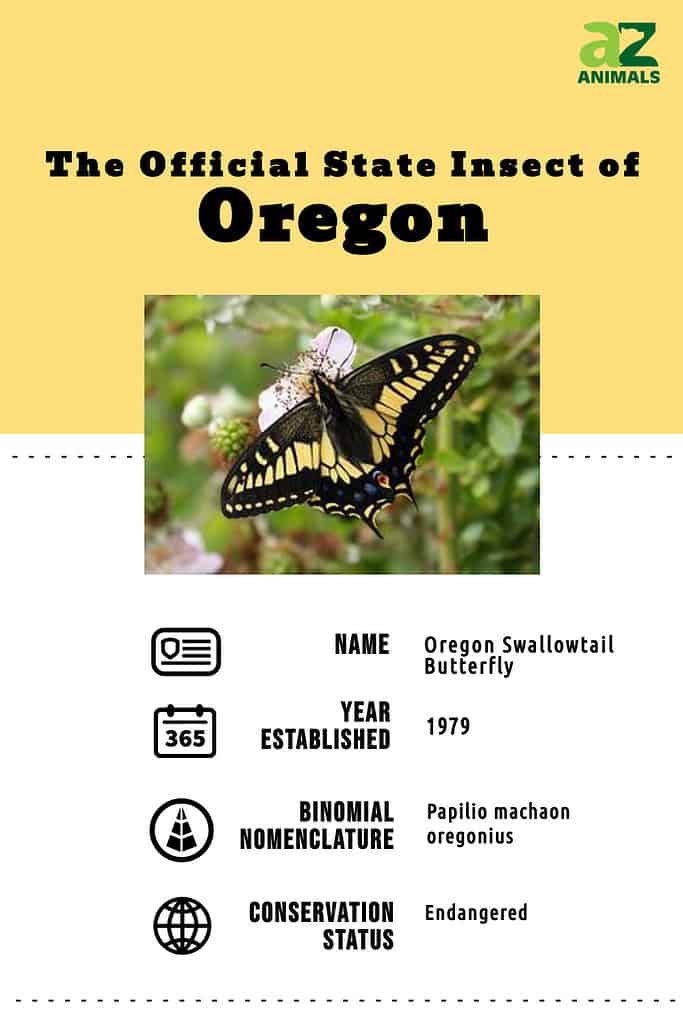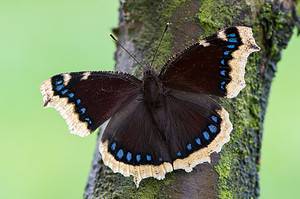Most states have a state insect, which can range anywhere from dragonflies to bees to a multitude of different butterfly species. But what about the state of Oregon? What is the Beaver State’s designated official state insect? In this guide, we’ll explore everything you need to know about the Oregon state insect.
What is the Oregon State Insect?
The official Oregon state insect is the Oregon swallowtail butterfly. It is classified as Papilio machaon oregonius, Papilio oregonius, or sometimes as Papilio bairdii oregonius. The western region of North America is home to this magnificent species of butterfly. It is a member of the Old World swallowtail butterfly subspecies, which lives throughout Asia and Europe. The Oregon swallowtail butterfly is revered for both its aesthetic appeal and ecological significance.

Appearance
The wingspan of the Oregon swallowtail butterfly can reach four inches wide, which is quite substantial. Its body is yellow with black spots and stripes on it. The wings are mostly yellow with dots and stripes in black.
The swallowtail butterfly family has long tails on the hindwings. Predators can be misled by the tails and avoid them. That means that they are used as a form of protection. The butterfly’s wings are also marked with blue and orange, which further enhances its remarkable look.
Biology
Grasslands, meadows, and open forests are just a few of the environments where the Oregon swallowtail butterfly may be found. It frequently appears close to streams and rivers where its host plants flourish. The nectar of flowers like milkweed, thistles, and phlox is what the butterfly consumes.
The larvae (better known as caterpillars) of this species consume the leaves of many different plants, such as fennel, dill, and wild carrot. These caterpillars have two yellow-orange spots behind their heads and are green with black stripes on them. Before pupating, the caterpillars go through a number of molts.
Life Cycle
The Oregon swallowtail butterfly has a life cycle that includes four stages: egg, larva, pupa, and adult. On the leaves of their host plant, the female butterfly lays her eggs. Before hatching, the eggs’ light green color changes to a yellowish-brown hue. The eggs hatch into larvae, which then start eating the host plant’s leaves.
Before becoming pupae, the larvae molt multiple times. The pupa looks like a little piece of wood and is brown in color. About two weeks after the pupa is removed, the adult butterfly emerges. The life cycle of the adult butterfly is continued over its two to three-week lifespan by mating and laying eggs.
Conservation Initiatives
The Endangered Species Act lists the Oregon swallowtail butterfly as an endangered species, making it a protected species in the state of Oregon. Numerous hazards, including habitat loss, pesticide usage, and climate change, have adversely affected this beautiful butterfly. Due to agriculture and land development, the butterfly’s host plants are also in danger of extinction. The butterfly is now the target of several conservation initiatives, including habitat restoration, captive breeding, and public awareness campaigns.

On June 6, 1977, the United States Postal Service issued a stamp specific to the Oregon swallowtail.
©Kenneth Wiedemann/iStock via Getty Images
How to Identify an Oregon Swallowtail Butterfly
Finding an Oregon swallowtail butterfly in the field and correctly identifying it can be thrilling and quite a lot of fun! When attempting to identify this lovely butterfly, keep in mind the following salient traits and qualities to search for.
Size and Appearance
The Oregon swallowtail butterfly has a huge wingspan that may reach four inches. Its wings are distinctively shaped, with long, tapering hindwings that finish in tails and extended forewings. The swallowtail family is distinguished by its appendage that resembles a tail.
Coloration
The butterfly has an eye-catching color pattern. The wings are mostly yellow with dots and stripes in black. Typically, the black wing stripes are broader towards the body and thinner at the wing margins. The blue and orange patterns on the hindwings stand out against the background of yellow. The striking contrast of yellow, black, blue, and orange produces an arresting show.
Notable Markings and Shapes
Oregon swallowtail butterflies have yellow bodies with black stripes and spots on them. They are slim and elongated around the abdomen. The head’s size in relation to the body is rather tiny.
Tails
The long tails on the Oregon swallowtail butterfly’s hind wings are one of its distinctive characteristics. These thin, tail-like wing extensions can distinguish it from other butterfly species that may look quite similar.
Flight Patterns
Tracking a butterfly’s flying pattern is another great way to help identify it. The elegant and leisurely flight of the Oregon swallowtail butterfly is a notable characteristic of this subspecies. It frequently flutters and glides softly, allowing you to take in its beauty. These types of butterflies do not zoom away or fly very fast.
Environment
It’s crucial to think about the Oregon swallowtail butterfly’s preferred environment when searching for it. Look for it in settings where its host plants flourish, such as grasslands, meadows, open forests, and places close to streams or rivers. Remember that the butterfly’s presence may change based on the season and the surrounding surroundings.
Butterfly-Watch Safely and Ethically
In order to properly see a butterfly in the wild, you must show both respect for it and its surroundings. You should take care not to harm its host plants or the environment by touching or disturbing it. Enjoy this spectacular butterfly’s beauty from a respectful distance, and consider taking pictures or making notes about it for future research or conservation efforts.
Where Oregon Swallowtail Butterflies Live

Oregon swallowtail butterflies can be found in abundance throughout the state of Oregon (pictured).
©Cascade Drone Photography/Shutterstock.com
The Oregon swallowtail butterfly gets its name from the fact that it is mostly found in the state of Oregon. It is the Oregon state insect, after all! They live in a variety of environments throughout the state, but they are most common in Oregon’s western region. The existence of particular host plants and conducive environmental factors directly affect the butterfly’s dispersal throughout the state.
Common habitats for Oregon swallowtail butterflies are grasslands, meadows, open forests, and riparian zones. The resources needed for their survival are available in these settings, including host plants that are ideal for egg-laying and larval development as well as nectar-rich flowers for adult food sources.
The presence of their chosen host plants is one of the main variables affecting the range of Oregon swallowtail butterflies. They have a close relationship with a number of plant species, including the wild carrot, anise, and other members of the Apiaceae family of carrot plants. The butterfly caterpillars eat the plants that act as hosts.
Specific Locations Where One Can Find Oregon Swallowtail Butterflies
In Oregon, the areas with the densest populations of these butterflies are often those with a high concentration of their host plants. For instance, it is well known that this butterfly species has substantial populations in the Central Willamette Valley, which includes the areas close to Corvallis, Salem, and Eugene. With a variety of appropriate habitats, including open meadows and grasslands, this area offers optimal circumstances.
This butterfly is often linked to riparian regions, such as those near rivers and streams, where its host plants flourish. These locations can be found all throughout Oregon and act as vital pathways for the migration and distribution of butterfly populations.
The environments required for the Oregon swallowtail butterfly’s survival are the main focus of conservation efforts in Oregon. This entails safeguarding riparian zones, grasslands, and meadows as well as encouraging the development and upkeep of its host plants. In order to maintain the preservation of this unique species in its natural habitat, it is important to understand the precise locations and environmental needs of Oregon swallowtail butterflies.
Oregon Swallowtail Butterfly Mating Process
The interesting and complex mating ritual of the Oregon swallowtail butterfly is essential to its ability to reproduce. The mating ritual of the Oregon swallowtail butterfly, like those of many other butterfly species, includes a variety of activities and interactions between males and females.
Males start the process by aggressively looking for females in appropriate settings. When a male comes into contact with a female, he begins wooing her by flying in erratically around her. This aerial performance accomplishes a number of objectives, including attracting the female’s attention, showing his physical prowess and agility, and deterring other male competitors.
The male releases pheromones during the courting flight, which are chemical messages that can attract and communicate with the female. These pheromones aid in determining if the male is a good candidate for mating. The female may react by flying more carefully and deliberately to show her interest and receptivity after identifying the pheromones and the male’s wooing efforts.
Following a successful courting, the couple settles on an appropriate perch, sometimes a plant or a leaf, and carries on their “date” there. By folding his wings, the male exhibits tandem behavior, which involves elevating himself over the female. This activity is believed to create a bond between the male and female that will lead to successful copulation.
Once they are in tandem, the male catches the female in his claspers, which are specialized appendages at the end of his abdomen. During copulation, this physical touch is essential for the transmission of sperm to the female. The male actually performs the mating process by bending his abdomen to make contact with the female’s reproductive system and transfer sperm.
Post-Mating Processes
Following mating, the female gets ready to deposit eggs on suitable host plants to ensure the continuation of the species. The male may disengage and continue looking for other partners after performing his function in reproduction.
The Oregon swallowtail butterfly’s mating ritual not only promotes reproduction but also contributes to population genetic diversity. The butterflies improve their chances of successful reproduction and the survival of their species by participating in courting activities and partner choice.

The
black swallowtail
caterpillar (pictured) is very similar in appearance to the Oregon swallowtail caterpillar.
©Graphicato/Shutterstock.com
What Do Oregon Swallowtail Butterflies Eat?
Both as adults and as larvae, Oregon swallowtail butterflies have specific dietary preferences. Getting the right nutrition is essential for their growth and survival.
Nectar from a variety of flowers is the main source of nutrition for adult Oregon swallowtail butterflies. They frequently stop by flowers like milkweed, thistles, phlox, and other plants that have a lot of nectar to offer. These nectar-rich blooms operate as a vital source of energy, giving adult butterflies the resources they need for tasks like mating and egg-laying.
The Oregon swallowtail butterfly’s caterpillars have highly specific eating habits. They only consume particular host plants, mostly members of the carrot family. Wild carrot, anise, and plants in the Foeniculum genus are among the most often used host plants, as was already noted earlier in this guide.
The Oregon swallowtail caterpillars have evolved to eat the host plant leaf, which contains vital nutrients for their growth and development. They chew and eat the leaves using their mandibles, or jaws. The caterpillars go through multiple molting stages during which they lose their exoskeleton and get bigger. They need more food as they develop since their bodies get bigger and they need more energy.
It’s interesting to note that the larvae of Oregon swallowtail butterflies have evolved to absorb and retain harmful substances from their host plants, known as furanocoumarins. The caterpillars have a defensive mechanism against possible dangers since these substances render the caterpillars unpleasant or poisonous to many predators.
Fast Facts About the Oregon Swallowtail Butterfly
There are so many cool facts out there about the Oregon state insect! Here are some more facts about the Oregon swallowtail butterfly:
- The state of Oregon designated the Oregon swallowtail butterfly as its state insect in 1979 to honor its beauty and importance to the state.
- Within its range, the Oregon swallowtail butterfly’s wings can have different colors. While individuals in western Oregon have more yellow and less black on their wings, those in eastern Oregon often have more black.
- The intriguing Batesian mimicry technique is used by the Oregon swallowtail butterfly. It imitates the deadly pipevine swallowtail butterfly (also known as Battus philenor) in appearance to ward off predators.
- The Oregon swallowtail butterfly has a two to three-week adult life span, which is not very long. They finish their life cycle, mate, and deposit eggs during this short time.
- The Oregon swallowtail butterfly has long tails on its hind wings that aren’t just pretty but are also used for defense. The butterfly’s ability to wag its wing-tails when in danger from predators confuses and scares away prospective assailants.
- When looking for a mate, female Oregon swallowtail butterflies are very picky. These butterflies tend to choose males with more vivid and distinct wing patterns because these are signs of genetic quality and fitness.
- The Oregon swallowtail butterfly’s usual flying period is from late spring to early summer. The adults emerge from their pupae at this time, mate, and lay eggs.
- The Oregon swallowtail butterfly depends on certain environmental factors and a variety of plants, and as a result, it is very susceptible to climate change. Its habitat and populations could be seriously impacted by climate change and related changes in temperature and precipitation patterns.
- Numerous Native American tribes in Oregon have cultural importance for the Oregon swallowtail butterfly. It is revered as a sacred and figurative animal that stands for evolution, beauty, and a connection to the natural world.
Conclusion
The Oregon swallowtail is a magnificent species of butterfly that is endemic to western North America. For its aesthetic appeal and ecological significance, it is widely prized and fairly easy to identify. Several conservation initiatives are being undertaken to safeguard the butterfly since it is considered endangered. Let’s hope that the Oregon state insect has a better, brighter future!
The photo featured at the top of this post is © Steve Byland/Shutterstock.com
Thank you for reading! Have some feedback for us? Contact the AZ Animals editorial team.







